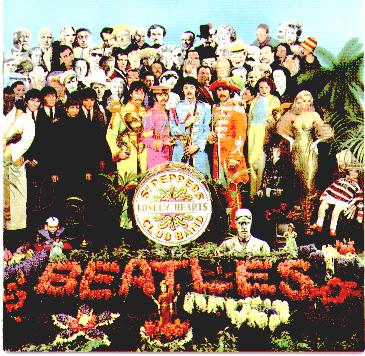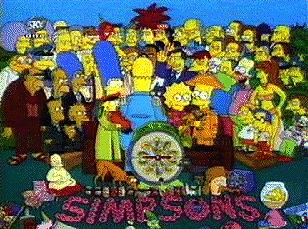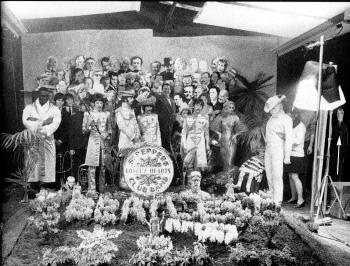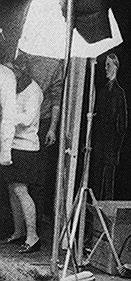Accordion Beatles
For Sale
Free Clips HERE!
Accordion Floyd
Website Awards
Accordion Awards
Background & Info
The Roadie Years
Sir George Martin
Interview
Buckwheat Zydeco
Repertoire
Gigs
FAQs
Links
Contact
Y2K Compliance
and Bonus Audio

ACCORDION BEATLES PROUDLY PRESENTS
FOR THE FIRST TIME IN ROCK AND ROLL HISTORY
The Beatles'
"A Day In The Life"
on Solo Accordion
Arranged and performed by
Domenic "the Accordion Beatles guy" Amatucci
| Part I | Part II | Part III |
| 730 Kb AU file - 1:33 | 643 Kb AU file - 1:22 | 560 Kb AU file - 1:11 |
PERFORMED LIVE AT THE ORILLIA BEATLES FEST
IN ITS ENTIRETY ON VIDEO!

from "Sgt. Pepper's Lonely Hearts Club Band" released in 1967
About "A Day In The Life"
by "the Accordion Beatles guy"
Generally regarded as one of the Beatles' most finely conceived, ethereal, profound and complex compositions, "A Day In The Life" is a fitting end piece to this epochal, revolutionary and timeless album, whose every song stands as a classic: the psychedelia of 'Lucy in the Sky'; the unheard-of tape splicing techniques pioneered by George Martin in 'Mr. Kite'; the delightful ditty 'When I'm 64'; the elaborate layering, sound effects and wild stereo panning of 'Within You Without You'; and Paul's developing orchestral side (under George Martin's tutelage) on 'She's Leaving Home'. This album is truly a masterpiece of its own, or any, time. The last thing you actually hear on the album, once that massive last note of 'A Day in the Life' fades slowly away, is the spiral groove at the end of the LP, which on an actual LP, would play ad infinitum, and which makes the album finish in yet another truly innovative and remarkable way, which always was the Beatles way, in that every bit of the vinyl was used to display the Beatles' imprimateur.
The album stands out for so many reasons, not the least of which is its place in rock history as the first concept album, which presents the Beatles in alter ego, allowing them to leave behind the Mop Top image they were eager to shed. This also allowed them to go in radically new directions without losing their audience, while allowing them to redefine what "The Beatles" were, as their subsequent output proved. If anything, this album delighted everyone, and grew their audience to include the audiophiles and 'long-hair music' lovers, a term which up to then referred to classical music. 'Sgt. Pepper' was an artistic revelation that started the whole psychedelic movement on a mass market scale, and infiltrated art, music, film, fashion and all of pop culture.
The record's audience sounds, segues, bits of dialogue and BBC archive material, along with its intricatelly woven subtext, underlying research and technological developments, show an inventiveness that far surpassed the technical ability of the equipment then extant to capture it; but with Sir George behind the dials and old pole-type faders, they found a way through sheer determination and necessity. Selling a lot of records in the previous three or four years also afforded them the opportunity to explore avenues that today would make the top management of big selling artists with some longevity have seizures, should their own stars decide to radically veer from their image and genre into experimental realms of sound and recording techniques so bizarre that studio technicians would probably walk off the job. In fact, if you look at many of the old-time big rock bands (Eagles, Styx, Aerosmith, etc.), it seems that they are coming back on nostalgia tours as parodies of themselves (esp. Aerosmith!).

Even the cover, oft imitated and parodied (oh those Simpsons!), is an artistic and cultural achievement, a collection of pop culture and historic icons, that itself now stands as an iicon, and marks pop culture and significant history to that point, in one immediately-recognizable frame of reference. The supposed 'hidden' imagery in the cover, I won't even touch (mostly Paul-is-dead stuff). However, it is a fact that Adolf Hitler was left out of the final shot, which was a good decision, but not one forced by EMI or Parlaphone. A full-sized cut-out of der Feuhrer, same as the others, can be seen leaning against the far right side of the set, just out of the frame, indicated in the image below left by the small white arrow. The next two images zoom in on the figure. Jesus and Elvis were also left out of the final version. Interestingly, Ghandi was included but was later removed through photographic retouching.



A great site that covers the Sgt. Pepper's cover in quite some detail is here. (links open in new window)
A great site with a lot of obscure tidbits is here.
This one explores the "Paul is dead" aspects.
This song was first proposed to me partly in jest and partly as a dare, to which, of course, I was compelled to rise. I learned it by playing along with the Sgt. Pepper's CD, and it is played here in the same key (G major) as the album. I have performed this piece in public only a few times, and so I think it's safe to say that this is the first time you will ever hear it played on solo accordion. In this song, I attempt to interpret the many instruments and overdubbed tracks, with the biggest challenge being the "orchestral orgasm", although Paul's middle eight presented some problem as well (that music hall bass line is coming along!). John's wispy intro and haunting vocal melody came more naturally to me, as did the massive chords in the "ahhhh ah-ah-ahhhh" part. It helps too, that the bass and rhythm of this part follow a natural progression down the left-hand side of the accordion.
Please enjoy, but remember, this is a work in progress, so stay tuned for future revisions.
It will also be included on the CD which I plan to release in the near future.
If you've heard this song done in a comparable manner, please let me know.
[the following is excerpted from Ray Coleman's "Lennon: The Definitive Biography" (Harper, 1992) p.541]
"[Sgt. Pepper]'s supreme achievement is still the massive 'A Day In The Life'. Again Lennon culled the song from disparate sources - newspaper headlines, his filming of How I Won The War in Spain in 1966, and snatches of conversation. Paul's middle eight slotted neatly into the scenario. After hearing the words 'went upstairs and had a smoke', the B.B.C. screamed 'drugs' and promptly banned the song. Lennon's jaundiced vocal is perfectly suited to the distanced picture of a man seated, 'read[ing] the news today', and from that preface the song unfolds. The seemingly random flow ends with the enigmatic line which was inspired by a friend: 'Now they know how many holes it takes to fill the Albert Hall.' 'A Day In The Life' marked the pinnacle of the Beatles' recorded output. It tested George Martin's abilities to the breaking-point, in his having to encourage a classical orchestra to 'freak out', and to come up with an arrangement that sounded like 'the end of the world', sustaining the final note for forty-two seconds."
I've read many things about this song, and have gathered the following additional tidbits. Some can be attributed to the George Martin 'Interview' at Canadian Music Week '98, others to Barry Miles' "Many Years From Now" (the Sir Paul bio), and the Sgt. Pepper's CD liner notes. I am working from memory here, so please feel free to contact me and let me know what parts I got wrong.
John conceived and wrote the overall song, while Paul supplied the middle eight, or the "woke up, got out of bed" part. Recording commenced on January 19, 1967 in Abbey Road's studio two. The working title was "In The Life Of..." The "orchestral orgasm" has a lot of lore attached to it. It started out as 24 bars of Paul keeping time on the piano, while George Martin counted the measures out. The actual score that was passed around to the many orchestra members from the London Symphony Orchestra contained two passages of 24 bars (before the middle eight and of course at the end) which showed the starting note, then a wiggly line that slowly rose up the staff, where the players were expected to "fill in" whatever they thought fit. This all came together with the massive E major that ends the second of the passages, which also ends the song, the final chord being held for 42 seconds. For formally-trained orchestra players, accustomed to a conductor and his meticulously-arranged parts, this was quite a stretch. George Martin tried to explain to them that he was looking for a monumental glissando/crescendo, a huge unique sound that would be the aural equivalent of an orgasm or the apocalypse. He told them to listen, and that if they were playing the same thing as their neighbour, then they were playing the wrong thing.
They tried and tried to nail it, and finally, they took a break, during which time the lads stepped out for some 'herbal jazz' cigarettes. They got back to the studio before George Martin, and started to loosen up and joke around with the other players. Some versions suggest that a few of these symphonic players actually went out on the break with the lads, and others still say that the smoking occurred in the studio. It was an evening session, and there were other stimulants about, including alcohol. At any rate, Sir George returned to find one of the greatest violinists in England wearing a big red clown's nose, while others had balloons tied to their bows. The mood was right, and the right sound was achieved. You can hear either Sir George or Mal Evans (depending on whose version you go with) counting the measures. The alarm clock actually marks the point where the next bit begins, and was rung by Sir George/Mal to signal this to all the players.
The bloke who 'blew his mind out in a car' was an heir to the Guinness fortune, and an acquaintance of the Beatles. The war reference is from John's time spent filming the movie How I Won The War. The final verse was also plucked from the newspaper, and I recall Sir George affecting a broad Northern accent while quoting the local politician who had said 'We've got 4,000 'oles in Blackford Lancashire', when he discussed it during the interview. Paul's middle eight describes his earlier Beatles days, when he would hop the bus to go over to John's to rehearse and write songs. Going 'upstairs' for 'a smoke' referred to Paul's slipping up to the top floor of the bus, which was open to the sky, and puffing a 'herbal jazz' cigarette while on his way. The 'I'd love to turn you on' reference was also interpreted as a drug message, but in fact, was meant as 'I'd love to enlighten you' or 'open your mind'.
It would not be an understatement to say that 'A Day In The Life' ranks as the highlight of the album that was the Beatles' greatest achievement, and which has had no equal before or since in all of the last century's musical output, and not yet in the current century either. I have no doubt that this song,and many other Beatles classics, will be played for centuries to come, as the classical composers are still played and loved today. There is a saying in the music business to describe a hot new act, as well as every A&R man's Holy Grail: 'the next Beatles'. Although this title has been conferred upon many acts since the Beatles, none has really been as big a hit or as profound an influence on pop culture all by themselves. It is unlikely that society may find itself in the position it did in 1963-64; modernity had yet to reach its own pinnacle, to melt down into the post-post-modern/cyber cultural miasma in which we find ourselves today. The fragmentation of the music market further reduces the likelihood of a trans-genre sensation that could span the generation/colour/socioeconomic gaps that are more deeply ingrained today, and which necessitate diverse marketing and communication strategies. Hot new acts go through the 'product life cycle' much more quickly these days; a jaded, hungry and over-sold consumer public, who one day holds up an artist as an icon of talent and sexy beauty, and mere months later, mocks, parodies and tabloidizes them, now demands a "flavour of the month" approach, which has largely been dictated by record companies and their marketing departments, to sell more records. The old show biz saying has been updated to "Here today, gone later today." A majority of the music hype and dollars is directed at the under-twenties, who buy the most records. Those hot acts have their year or two at thte top, then are disposed of in favour of the next one, usually younger, cuter, but just as mass-marketable. Even the so-called 'alternative' market works this way; very few of today's adults know who Limp Bizkit or Kid Rock is. Disposable commodities with a limited shelf life dictated by fashion. This is the same type of planned obsolescence that the fashion industry relies on. Good quality clothing can last many years, but clothiers won't sell as many if they don't widen the lapels, raise or lower the skirt hems, widen or narrow the ties, every year or two. But ask anyone from 7 to 70, and they'll know who the Beatles are. Will we be hearing orchestral arrangements of Kid Rock or Eminem tunes played on elevators or while we shop, 40 years from now? I really doubt it. However, I am confident that the Beatles and their music will still be a strong part of our global culture and heritage in the many decades and even centuries ahead.
Very few popular rock and roll bands have had world-wide sales that match the historic Parlaphone/EMI Beatles releases, especially when you consider that over 40 years ago, corporations and their distribution systems weren't as organized or widespread as today; that globalization of culture and markets had not yet really occurred (it could be argued that The Beatles went a long way in bringing this about); MTV, widespread satellite TV and music videos didn't exist; the populations of all countries were smaller; rock and roll was still very new, and at the time, was considered a fad; the technology to record, play back and broadcast the music was so primitive. More recent Apple Corps releases are exciting and, when they were released during the latter part of the '90s, caused as much or more excitement, hype and sales than any top seller of the time. 'Live at the BBC' and the "Anthology" CD and video collections put the Beatles back on the Billboard charts 35 years after they had their first hit. Very few artists can claim now, or will be able to claim once 35 years have passed since their first hit, that esteemed level of distinction.
Today, any schmuck with a good PC or Mac, and some audio recording software, can churn out hi-fi CD-quality multi-track audio, then mix, master and burn their own digitally-recorded, digitally-mixed and digitally-mastered CDs, then promote, offer samples, and sell them over the Internet. So where are the modern contenders to the coveted title of 'the next Beatles'?
Will there be another Beatles? Who needs another Beatles, when we already have the original often copied but never duplicated one and only Fab Four!

Home
